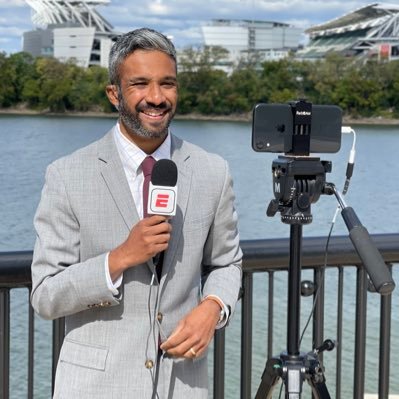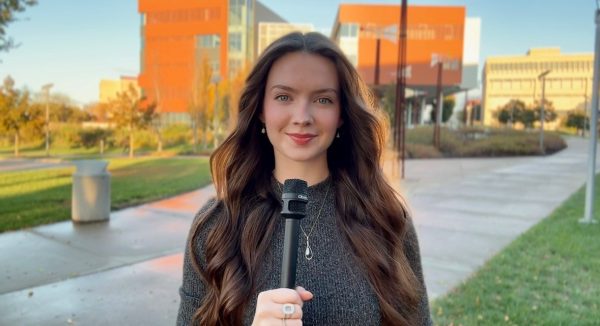A wreck on I-471 blocks traffic from 4-5 p.m., causing havoc on the road. A skilled third-grader at Ruth Moyer Elementary School in Fort Thomas, Kentucky, is rumored to be a wonderful singer and performs at a talent show. Whether the Bengals or Reds sign on a new player or the winner of the Flying Pig Full Marathon finishes in 2:26:01 – journalists are there.
The reporters, writers and producers in the Greater Cincinnati region have come from across the country, obtained degrees (or are working toward the honor) and spent countless hours deciding their “why.”
Why report the news? Why dip their toe in the “fake news” infested waters? Why here, in Northern Kentucky and the Queen City?
Working as a team: WLWT Senior News Producer Marcelle Webster
When she was young, Marcelle Webster, the senior news producer at WLWT News 5, found herself glued to the TV screen right after class to watch “Ellen.” The local news came on quickly after, however, and she would curiously stay engrossed through the night.
The Atlanta native began taking a journalism course in high school and dove into reporting as the sports editor, falling madly in love with the storytelling process. Going to games, talking to players and covering high-intensity moments fueled a passion Webster was cracking into, but she realized that she didn’t love sports enough for it to be her career.
“What do you mean I have to cover swimming and lacrosse and things I have no idea about or have no interest in? That’s where I started making the transition into local news,” she said.

Going onto college at The University of Alabama, Webster would attend city council meetings. She found it thrilling to report fairly—learning and interviewing both sides, informing the public, finding the most concise way to deliver the story and investigating to find the answers.
She spent her whole undergraduate experience working in newspapers, and it wasn’t until her final semester that broadcasting was introduced to her world. When she realized she yearned for more understanding in that field, she headed to the University of Missouri for her master’s degree.
Immediately following her education at Mizzou, Webster found herself in the Queen City as a producer at WLWT. Today, she lives out her dreams of deciding what news is most important and relevant to everyone in the area.
“Working in a newsroom is a very collaborative process which I think takes off a lot of the pressure,” Webster said about the weight of her job. “We have an editorial meeting where a dozen of us sit in this room and talk about what stories we’re going to do. We talk about why one is more important than the other, why one might deserve two minutes versus 30 seconds in the show.”
Webster covers parts of Kentucky, Ohio and Indiana with one goal in mind: to tell the stories that are most relevant to her audience.
“When you talk about newsworthiness and impact on people, it’s weather, money and it’s elections,” she said.
A lot goes into the process when deciding what to put on each and every segment. If national news is shown at the 5 p.m. slot, then hyperlocal news (traffic closures, local politics, etc.) will play in the 6:30 p.m. slot to not wear out the audience. If she covers President Donald Trump bashing former vice president Kamala Harris, she has to show a quote from Harris in the same light or defending herself.
People often raise a concern about “sad news” or complain that the news is too daunting. Webster has to consider the hearts and emotions of her audience in these moments.
One day in the newsroom, Webster received police camera footage of a shooting in Chicago. The video included a teenager, maybe 13, and the incident devastated her. It was the first time she ever cried at work. She took herself out of the situation and asked herself, “Do my viewers need to see this?”
“A phrase we say in the newsroom is, ‘Don’t import bad news.’ We have enough bad news of our own, we don’t need to hear about the sad and terrible things happening across the country every time,” she said.
Making decisions of what is important to Cincinnati causes Webster to have “pinch me” moments, where she can’t believe this is what she gets to do for a living.
She finds a thrill in reading viewers’ comments on social media to find story ideas, being immersed in the community or sharing the “bread and butter” of WLWT–breaking news–or telling viewers about her favorite kind of story–animal rescues.
Webster said there is a lot of pressure, but it isn’t so bad.
“There’s no one person who is making all of the decisions and trying to sell a certain perspective or deliver a certain bias. There is no agenda setting,” Webster said.
She is always leaning on the next day and the next show to prove to the audience WLWT is here for the Queen City.
Developing thick skin: ESPN Bengals Staff Reporter Ben Baby
Since he was 5 years old, Ben Baby had a dream. He had a passion for being involved in sports without playing them and read newspapers any chance he got. He later went on to write for his high school newspaper for three years.

Once he got to the University of North Texas, he began working with the college radio station, KNTU, and later went on to work for the student newspaper, North Texas Daily.
Like many other journalists who he graduated with, Baby received an offer quickly out of college. He worked his first full-time journalism job, at what he called his “dream job” at Denton Record-Chronicle, covering Dallas morning news as well as high school happenings.
It wasn’t until he received an offer in 2019 to be a staff reporter at ESPN for the Cincinnati Bengals that his world was flipped upside down. Directly after marrying his wife and going on their honeymoon, Baby accepted the position and moved to the Queen City. He is now one of the 32 professionals covering the NFL franchises for ESPN.
Always having a high standard for his writing and work as a journalist, Baby fit perfectly into the Who Dey nation, which has rapidly grown since quarterback Joe Burrow joined the team. Ja’Marr Chase and Burrow have expanded ESPN’s viewership to not only the Greater Cincinnati area, but the entire world.
Now, every day he wakes up and goes into work looking to announce who the Bengals signed, writing game coverage, interviewing key players like Burrow or Head Coach Zac Taylor, attending every press conference and even creating relationships with the people in the Bengals franchise.
Baby covers the Bengals truthfully and factually, which means the story may not always be positive. He is sometimes accused of hating on the city since the bad news is under his byline.
“Whenever the team isn’t doing well and I am reporting on them, you just get people like, ‘You just want to go back to Texas.’ And I think that’s what makes me angry the most,” he said as he expressed deep admiration and dedication to Cincinnati.
In these moments, Baby reflects on a time when he was reporting for a high school basketball team. The crowd was chanting cruel things to the coach and saying he should be fired. Baby pulled him aside after the game, confiding in him and asking him how he keeps on going. The coach said he would develop thick skin over time, and Baby ran with it.
He has been building an immunity to criticism for a while, reporting in regions where sports fans are die-hard and dedicated.
“If Ben Baby was fighting Al-Qaeda, I’d root for Al-Qaeda,” said a Tweet that he received when he was reporting in Texas. He now knows this was making him better and stronger.
After learning the difference between real constructive criticism and a hate comment, he became even more secure in his practice and everything he puts into his stories.
“It goes back to making sure you have a good process, that you are confident and resolute in how you do the job. Because if you do it the right way, those things don’t really matter,” he said.
Baby confidently hops on SportsCenter from time to time, writes features like the one he did on Taylor’s Starbucks friends back in Southern California and talks to some of Cincinnati’s favorites like Chase and Tee Higgins on a daily basis.
“Our job is one of the few that everybody knows, on any given day, whether you did a good job or not,” said Baby. “For me, everyone knows exactly what I did at work that day, because it’s all available to the public.”
Being enthralled in the craft: The Northerner Editor-in-Chief Emily Sisk
Since the first grade, Emily Sisk had an authentic passion for journalism. She went on a field trip to the zoo and took notes on everything she saw. She even began interviewing her teacher, and then went home and wrote her first article, an event story.

Trusting in her instincts, she looked back on what she loved as a little girl and decided journalism was the major for her.
In her first semester at NKU, she was in a course with all upperclassmen with Dr. Steve Bien-Aimé, learning a strong foundation of how to write in journalistic style. Not only was Sisk fascinated by the course, Bien-Aimé was fascinated by her ability to pick the practice up so quickly. He encouraged her to apply for The Northerner.
After a few months, Sisk decided to check out a Northerner meeting to see what it was all about, and by November, her first story was published. At the end of the year she applied to be on staff and was offered the paid position of news editor.
When NKU’s budget fell into a deficit, Sisk realized how impactful her writing could be. She conducted an exclusive interview with NKU’s chief financial officer, provost and vice president of Student Affairs, which turned into an extensive article educating Northern Kentucky on the financial status of the university.
The story was picked up by LINK nky and other local news stations quoted it for their own articles. It wasn’t until Spectrum News aired a story about NKU’s deficit and Sisk’s article was on television that she realized how big her work could be.
Sisk pointed out the challenge of being a student journalist and writing stories that weren’t always positive for the university.
“You’re going to this university that you choose to go to, but on the other hand being a journalist—being independent and reporting what is going on—you take on stories that don’t make the university look good,” Sisk said.
All within the year of being news editor, she covered NKU’s budget deficit, the president leaving, the basketball team going to the NCAA tournament and more, throwing her right into the practice.
“There was such a core group at the time with Killian [Baarlaer], Braden [White] and Mildred [Nguyen],” Sisk said. “We just dropped everything, fit it into our schedules and just covered it.”
Her junior year she thirsted for more in her practices and became enthralled at the idea of broadcasting, reporting, anchoring and more. During the spring semester, she was offered an internship with Kentucky Education Television (KET), was taking classes and performing as The Northerner’s managing editor. Two days a week she drove from Northern Kentucky to Lexington and the other three she spent at NKU studying, writing, reporting and doing anything to become a better journalist.
Her senior year she was offered the role of editor-in-chief and was trusted with the task of leading The Northerner to success. On top of that, she began a part time job with KET and hasn’t slowed down.
During her time in college, she has discovered a thrill in reporting on events and breaking news.
“You can uncover huge stories for thousands of readers that depend on you to tell you about things they would never know otherwise,” she said.
At the same time, Sisk has found a love for telling the full story, and learning that it is not just quick coverage that is important.
Sisk originally covered a story about a young NKU student who was in critical condition from being shot by a family member in a murder-suicide case. She then thought to herself that she had a duty to cover the deeper story.
“After I cover a story, a tragedy like that, I take the responsibility upon myself, to see how much deeper I can dig to do the story justice and do the people justice,” she said passionately.
Sisk got in touch with three of the girl’s best friends and discovered who Samantha Cain was as a person and her condition in the hospital to provide an update to her audience. This story made Sisk feel more than being the writer of a story or a few words on a page.
As she nears graduation, Sisk has published more than 150 articles, conducted extensive interviews with important people and written in-depth coverage. She feels prepared going into the professional world and couldn’t feel better about walking across the stage at commencement.
“It doesn’t really feel like a culture shock for me,” she said. “I have ingrained in myself that everything I have done, either with The Northerner or published on LINK nky, has already been professional and real.”
The why
There is a common thread between the three journalists: a love of telling stories, truthfully and accurately. Despite the constant decision making, occasional audience criticism or the pressure of reporting the full story, they all express an enthusiasm for their profession.
“I kind of just love the storytelling process: showing both sides, informing the public and finding the most concise way to deliver the most important information,” Webster said.
“When you’re in the writing process you want your story to have a lasting power and stand the test of time. I want this to be as good as I can,” Baby said.
“There is no other field where I would get to become an expert in everything and dabble in everything from sports to art to breaking news,” Sisk said.


